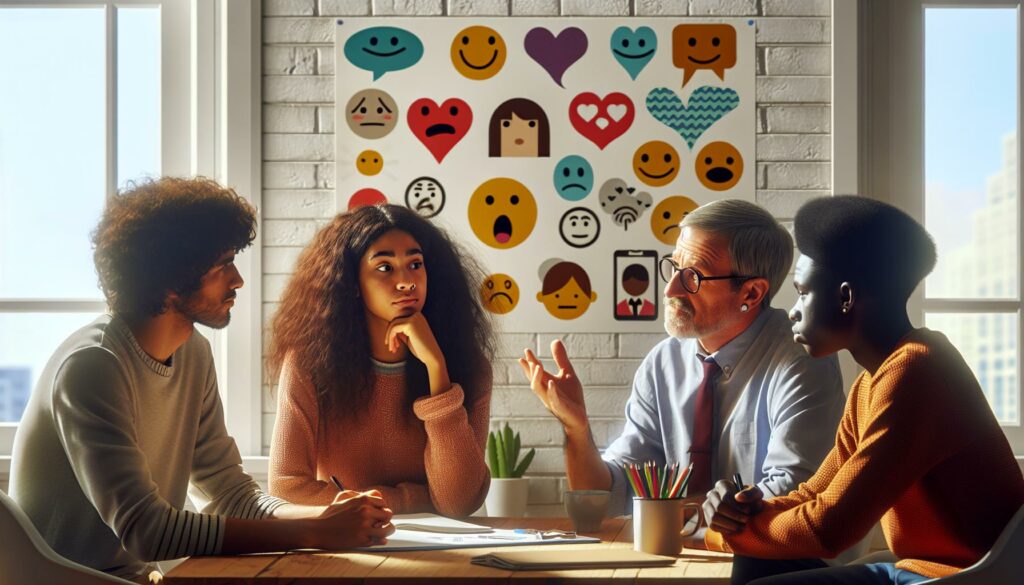In today’s visually driven world, emotional health clipart has become a vital tool for communication and expression. Whether you’re creating educational materials, designing presentations, or enhancing social media content, these images can convey complex feelings and ideas in an instant. I’ve found that incorporating clipart related to emotional well-being not only enriches the message but also makes it more relatable.
As we navigate the challenges of mental health awareness, using the right visuals can foster understanding and connection. From cheerful illustrations to thoughtful representations of struggle, emotional health clipart offers a spectrum of imagery that resonates with diverse audiences. Join me as I explore the significance of these visuals and how they can elevate our conversations about emotional health.
Key Takeaways
- Visual Communication: Emotional health clipart enhances communication by visually representing complex emotions and mental health concepts, making them more relatable.
- Importance for Awareness: These images play a crucial role in raising mental health awareness, promoting empathy, and destigmatizing discussions surrounding emotional well-being.
- Diverse Styles: There are various styles of clipart, from cartoonish to realistic, each impacting how emotions are perceived and the effectiveness of messaging.
- Resource Accessibility: Quality emotional health clipart can be found across various online platforms, including stock photo websites, free repositories, and design tools.
- Effective Usage: Incorporating emotional health clipart into educational materials and social media campaigns can enhance engagement, facilitate discussions, and support diverse learning styles.
- Choosing Wisely: It’s important to select high-resolution, relevant, and adaptable clipart while understanding the licensing agreements to avoid legal issues.
Emotional Health Clipart
Emotional health clipart serves as a visual representation of feelings, thoughts, and concepts related to mental well-being. These images enhance communication by making abstract ideas more tangible and accessible.
Definition And Purpose
Emotional health clipart includes graphics that depict emotions, mental health themes, and supportive messages. These visuals help convey complex emotional states in an immediate and relatable way. The purpose lies in clarifying discussions, enabling individuals to express feelings more clearly, and aiding educators and practitioners in facilitating conversations about emotional health.
Importance In Mental Health Awareness
Emotional health clipart plays a vital role in raising awareness about mental health. By providing visuals that depict both positive and negative emotions, these images foster understanding and empathy. They promote open discussions in various settings, including classrooms and online platforms. Effective use of clipart can destigmatize mental health issues, making it easier for people to share their experiences and seek help.
Types Of Emotional Health Clipart
Emotional health clipart covers diverse styles and themes, catering to various emotions and contexts. Understanding these types enhances effective communication and support in emotional discussions.
Illustrations For Various Emotions
Illustrations targeting specific emotions, such as happiness, sadness, anger, and anxiety, play a crucial role in conveying feelings. Each image can evoke a particular emotional response, allowing viewers to relate to the content closely. Examples include:
- Happy Faces: Bright colors and smiling faces symbolize joy and positivity.
- Sad Characters: Darker tones and frowning expressions represent sorrow and grief.
- Angry Figures: Sharp angles and intense colors convey frustration and anger.
- Calm Imagery: Soft, soothing visuals illustrate serenity and peace.
These illustrations can serve as conversation starters, help clarify feelings, and foster empathy among individuals when discussing emotional well-being.
Clipart Styles And Their Impact
Clipart styles significantly influence the perception of emotional health messages. Various styles can create different atmospheres and feelings, such as:
- Cartoonish Designs: Fun and playful styles engage younger audiences, make discussions approachable, and ease tension around serious topics.
- Realistic Images: Detailed and lifelike visuals foster a deeper connection, encouraging discussions around complex emotions.
- Minimalist Graphics: Simple designs promote clarity and focus, making it easy to convey essential messages without distraction.
Choosing the appropriate style ensures the emotion intended is communicated effectively, enhances relatability, and captures the audience’s attention.
Where To Find Quality Emotional Health Clipart
Finding quality emotional health clipart requires knowing where to look and how to evaluate the resources effectively. Several online platforms and tools provide a vast selection of clipart tailored to emotional well-being.
Online Platforms And Resources
- Stock Photo Websites: Sites like Shutterstock, Adobe Stock, and iStock offer extensive libraries of emotional health clipart. These platforms frequently update their collections to include contemporary designs that resonate with diverse audiences.
- Free Clipart Repositories: Websites such as Pixabay, Unsplash, and Clipart Library provide free access to various emotional health images. Although the quality can vary, many creators upload high-quality graphics suitable for professional use.
- Design Tools: Platforms like Canva and Crello include useful design features with integrated clipart. Both allow customization options that help me tailor clipart to specific projects, ensuring it aligns with my visual needs.
- Specialized Mental Health Resources: Nonprofit organizations and mental health initiatives often provide free clipart focused on emotional health. Their resources typically aim to promote awareness and support for mental health discussions.
- Resolution and Clarity: Quality clipart should have high resolution, ensuring clarity when printed or displayed on digital platforms. I check for images that maintain sharpness across various sizes.
- Relevance to Emotional Themes: I look for clipart that accurately represents specific emotions or thoughts. Evaluating the context of images helps ensure their effectiveness in conveying intended messages.
- Adaptability and Customization: Quality clipart is versatile. I prefer images that I can edit or adapt for different uses, enhancing my ability to fit them seamlessly into various projects.
- Licensing and Usage Rights: Understanding the licensing agreements is crucial. I verify whether the clipart can be used for commercial purposes or requires attribution to avoid any legal complications.
- User Reviews and Ratings: Platforms often feature user reviews that can guide me toward high-quality content. Checking ratings helps identify popular and well-regarded images suitable for my needs.
Using Emotional Health Clipart Effectively
I focus on strategies for utilizing emotional health clipart to enhance communication in various platforms. The right images can elevate the impact of messaging and foster deeper connections.
Incorporating Clipart In Educational Material
I incorporate emotional health clipart into educational materials to engage students effectively. Clipart depicting emotions like joy or anxiety can illustrate complex topics, making them relatable. For example, using images of diverse emotions in lesson plans or worksheets encourages discussions about mental well-being. Additionally, I use clipart in presentations to break the monotony of text-heavy slides, helping to maintain attention and enhance retention of information. Including visuals can also support students with different learning styles, facilitating a more inclusive educational environment.
Clipart In Social Media Campaigns
I utilize emotional health clipart extensively in social media campaigns to amplify messages. Images that represent feelings prominently resonate with audiences, increasing engagement and shares. For instance, utilizing clipart that depicts community support can drive awareness for mental health initiatives. I also focus on maintaining consistency in style and tone across all visuals, ensuring that each post aligns with the campaign’s overall message. By using relatable and emotive graphics, I foster conversations about emotional health, destigmatizing mental health issues and promoting a supportive atmosphere online.
Conclusion
Emotional health clipart is a powerful tool that can transform the way we communicate about mental well-being. By using visuals that resonate with our feelings and experiences, we can foster deeper connections and understanding in conversations about mental health.
Whether in educational settings or social media, the right images can spark discussions and encourage individuals to share their stories. As I continue to explore the vast world of emotional health clipart, I’m excited to see how these visuals can break down barriers and promote empathy.
With the right resources and strategies, anyone can harness the potential of emotional health clipart to make a meaningful impact.

